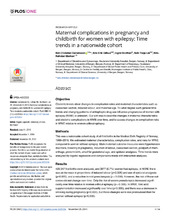| dc.description.abstract | Objective: Obstetric trends show changes in complication rates and maternal characteristics such as caesarean section, induced labour, and maternal age. To what degree such general time trends and changing patterns of antiepileptic drug use influence pregnancies of women with epilepsy (WWE) is unknown. Our aim was to describe changes in maternal characteristics and obstetric complications in WWE over time, and to assess changes in complication risks in WWE relative to women without epilepsy. Methods: This was a nationwide cohort study of all first births in the Medical Birth Registry of Norway, 1999–2016. We estimated maternal characteristics, complication rates, and risks for WWE compared to women without epilepsy. Main maternal outcome measures were hypertensive disorders, bleeding in pregnancy, induction of labour, caesarean section, postpartum hemorrhage, preterm birth, small for gestational age, and epidural analgesia. Time trends were analyzed by logistic regression and comparisons made with interaction analyses. Results: 426 347 first births were analyzed, and 3077 (0.7%) women had epilepsy. In WWE there was an increase in proportions of induced labour (p<0.005) and use of epidural analgesia (p<0.005), and a reduction in mild preeclampsia (p = 0.006). However, the risk of these outcomes did not change over time. Only the risk of severe preeclampsia increased significantly over time relative to women without epilepsy (p = 0.006). In WWE, folic acid supplementation increased significantly over time (p<0.005), and there was a decrease in smoking during pregnancy (p<0.005), but these changes were less pronounced than for women without epilepsy (p<0.005). Conclusions: During 1999–2016 there were important changes in maternal characteristics and complication rates among WWE. However, outcome risks for WWE relative to women without epilepsy did not change despite changes in antiepileptic drug use patterns. The relative risk of severe preeclampsia increased in women with epilepsy. | en_US |

